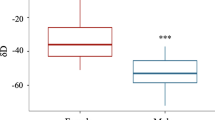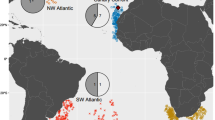Abstract
Long-distance migration is often associated with relatively short breeding seasons and a start of reproductive activities shortly after arrival. The full activation of the reproductive system from the regressed state takes, however, several weeks and must, therefore, be initiated in the winter quarters or during spring migration. Hence, long-distance migrants face a potential conflict between the energetic and temporal requirements of migration and the preparation for reproduction. We studied long-distance migratory Siberian stonechats in northern Kazakhstan and short- distance migratory European stonechats in Slovakia. We hypothesized that migratory distance and gonadal status at the time of arrival are related. We found that males of both populations arrived with gonads that were not fully developed. However, the populations neither differed in gonadal state at the time of arrival, nor in the rate of testicular development to the fully active state at the time of egg laying. The rate of the last stages of gonadal development may be determined by physiological constraints rather than by a trade-off between migration and reproduction. Within populations, passage migrants and local breeders could not be distinguished on the basis of their testicular development. However, passage migrants showed higher variation in gonadal size than local breeders, which could relate to the differences in migratory distance and hence reproductive timing.



Similar content being viewed by others
References
Baker JR (1938) The evolution of breeding seasons. In: de Beer GR (ed) Evolution: assays on aspects of evolutionary biology. Oxford University Press, London, pp 161–177
Bauchinger U (2002) Phenotypic flexibility of organs during long-distance migration in garden warblers (Sylvia borin): implications for migratory and reproductive periods. PhD Thesis, Technische Universität, München
Berthold P, Gwinner E, Sonnenschein E (eds) (2003) Avian migration. Springer, Berlin
Chernyshov VM (1982) Sravitel’naya ecologiya chernogolovogo chekana i varakushki v Barabinskoi lesostepi [Comparative ecology of the stonechat and bluethroat in the Barabinsk forest steppe], Razmeshchenie i chislenost’ pozvonochnykh Sibiri [distribution and number of vertebrates in Siberia]. Nauka, Novosibirsk, pp 84–110
Coppack T, Pulido F, Czisch M, Auer DP, Berthold P (2003) Photoperiodic response may facilitate adaptation to climatic change in long-distance migratory birds. Proc R Soc Lond B Biol Sci 270(Suppl 1):S43–46
Cramp S (1988) Handbook of the birds of Europe, the Middle East and North Africa, vol. 5. Oxford University Press, Oxford
Dawson A (2002) Photoperiodic control of the annual cycle in birds and comparison with mammals. Ardea 90:355–367
Dawson A, King VM, Bentley GE, Ball GF (2001) Photoperiodic control of seasonality in birds. J Biol Rhythms 16:365–380
Dement’ev GP, Gladkov NA (1954) Birds of the Soviet Union, vol. VI. Gosudarstvenno Izdatstelstvo Sovetskaya Nauka, Moskow
Fry CH (1972) Flight muscle hypertrophy and ecophysiological variation of yellow wagtail Motacilla flava races at Lake Chad. J Zool 167:293–306
Glutz von Blotzheim U, Bauer KM (1988) Handbuch der Vögel Mitteleuropas, vol. 11. Aula-Verlag, Wiesbaden
Gwinner E (1986) Circannual rhythms. Springer Verlag, Heidelberg
Gwinner E (1987) Annual rhythms of gonadal size, migratory disposition and molt in garden warblers (Sylvia borin) exposed in winter to an equatorial or a southern hemisphere photoperiod. Ornis Scand 18:251–256
Gwinner E (1989) Effects of photoperiod on the circannual systems of the collared and pied flycatcher, Ficedula albicollis, F. hypoleuca. J Ornithol 130:1–14
Gwinner E (1998) Photorefractoriness in equatorial migrants. In: Proceedings of the 19th International Ornithology Congress, Ottawa. Ottawa University Press, Ottawa, pp 626–633
Gwinner E (2003) Circannual rhythms in birds. Curr Opin Neurobiol 13:770–778
Gwinner H, Gwinner E, Dittami JP (1987) Effects of nestboxes on LH, testosterone, testicular size, and the reproductive behavior of male European starlings in spring. Behaviour 103:68–82
Gwinner E, Dittami JP, Beldhuis HJA (1988) The seasonal development of photoperiodic responsiveness in an equatorial migrant, the garden warbler Sylvia borin. J Comp Physiol A 162:389–396
Hedenström A, Alerstam T (1997) Optimum fuel loads in migratory birds: distinguishing between time and energy minimization. J Theor Biol 189:227–234
Lack D (1968) Ecological adaptations for breeding in birds. Methuen, London
McWilliams SR, Guglielmo C, Pierce B, Klaassen M (2004) Flying, fasting, and feeding in birds during migration: a nutritional and physiological ecology perspective. J Avian Biol 35:377–393
Merilä J, Sheldon BC (1999) Testis size variation in the greenfinch Carduelis chloris: relevance for some recent models of sexual selection. Behav Ecol Sociobiol 45:115–123
Murton RK, Westwood NJ (1977) Avian breeding cycles. Clarendon Press, Oxford
Nilsson J-A (1999) The fitness consequences of the timing of reproduction. In: Adams NJ, Slotow RH (eds) Proceedings of the 22nd International Ornthology Congress, Durban. BirdLife South Africa, Johannesburg, pp 234–247
Perrins CM (1970) The timing of birds breeding seasons. Ibis 112:242–255
Rising JD (1987) Geographic variation in testis size in savannah sparrows (Passerculus sandwichensis). Wilson Bull 99:63–72
Runfeldt S, Wingfield JC (1985) Experimentally prolonged sexual acticity in fermale sparrows delays termination of reproductive activity in their untreated males. Anim Behav 33:403–410
Sillett TS, Holmes RT (2002) Variation in survivorship of a migratory songbird throughout its annual cycle. J Anim Ecol 71:296–308
Silverin B (1975) Reproductive organs and breeding behavior of the male pied flycatcher Ficedula hypoleuca. Ornis Scand 6:15–26
Urquhart E (2002) Stonechats: a guide to the genus Saxicola. Christopher Helm, London
Weatherhead PJ, Metz KJ, Bennett GF, Irwin RE (1993) Parasite faunas, testosterone and secondary sexual traits in male red-winged blackbirds. Behav Ecol Sociobiol 33:13–23
Wikelski M, Tarlow EM, Raim A, Diehl RH, Larkin RP, Visser GH (2003) Costs of migration in free-flying songbirds. Nature 423:704
Wingfield JC, Moore MC (1987) Hormonal, social and environmental factors in the reproductive biology of free-living male birds. In: Crews D (ed) Psychobiology of reproductive behaviour: an evolutionary perspective. Prentice-Hall, New York, pp 149–175
Acknowledgements
We thank Tatyana Bragina, Evgenij Bragin and Anton Krištín for their scientific and logistic support. Dieter Schmidl, Peter Romanov, and Dana Dumbekova assisted in the field. Thanks to all colleagues from the Institute, especially to Dirk Geue for additional help in the field and Barbara Helm and Wolfgang Goymann for critical comments on the manuscript. The methods applied in this study were covered by a contract of collaboration with the Naurzum National State Reserve and a permit (č0205/0041/01-4,1 pil) of the Ministry of Nature Conservation of the Slovak Republic and complied with current laws of Kazakhstan, Slovakia and Germany.
Author information
Authors and Affiliations
Corresponding author
Additional information
Communicated by F. Bairlein.
Rights and permissions
About this article
Cite this article
Raess, M., Gwinner, E. Gonadal status upon spring arrival in long-distance and short-distance migrating stonechats (Saxicola torquata). J Ornithol 146, 325–331 (2005). https://doi.org/10.1007/s10336-005-0010-z
Received:
Revised:
Accepted:
Published:
Issue Date:
DOI: https://doi.org/10.1007/s10336-005-0010-z




